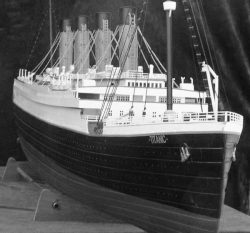RC SCALE RMS TITANIC 60 INCH LENGTH – READY TO RUN
Product#: TIT-001
INCREDIBLE DETAIL, DOWN TO THE MASTS AND RIGGING!!
INCLUDES INSTRUCTIONAL MANUAL, TRANSMITTER, RECEIVER, ELECTRONIC SPEED CONTROLLERS, RUDDER SERVO, 4 ENGINES AND DRIVELINE/COUPLERS/PROPS, AND SHIPS STAND...
THIS IS NOT A KIT - THERE HAS NEVER BEEN A HAND CRAFTED RTR SHIP LIKE THIS IN THE WORLD! NO BUILDING REQUIRED, CHARGE THE BATTERY AND GO! SCRATCH BUILT MODELS SUCH AS THIS SELL IN THE MANY, MANY THOUSANDS OF DOLLARS, BUT NOW THROUGH AN EXCLUSIVE FACTORY ARRANGEMENT, WE CAN BRING YOU THIS EXCEPTIONAL SHIP AT AN AFFORDABLE PRICE. SHIP HAS FULL MANUVERABILITY, LEFT/RIGHT/FORWARD/REVERSE.
THE TITANIC IS ONE OF THE MOST FAMOUS SHIPS IN THE WORLD!! NOW, YOU CAN OWN A PIECE OF HISTORY THAT HAS BEEN IMMORTALIZED IN BOTH MOVIES AND BOOKS. TO SEE THE RMS TITANIC CRUISING ELEGANTLY ACROSS THE WATER IS AND INCREDIBLE VISUAL EXPERIENCE. FROM ITS DISPLAY STAND TO THE LOCAL POND OR LAKE, NO ONE WILL EASILY FORGET THIS MAJESTIC SHIP AND ITS HAND MADE DETAILS. FROM ITS WOODEN DECKS TO ITS DURABLE FIBERGLASS HULL, THIS SHIP STANDS OUT AS A MASTERPIECE OF READY TO RUN MODELING.
IN THE WATER, THE SHIPS SCALE WAKE AND ITS STABLE MANUVERABILITY ARE EXCEPTIONAL. FURTHER, THE TITANICS 3 ELECTRIC ENGINES AND ELECTRONIC SPEED CONTROLLER (ESC) PROVIDES THE ABILITY TO VARY OR MAINTAIN SPEEDS WITH SMOOTH AND PRECISE ACCURACY. UNLIKE SMALL RC SHIPS, WAVE AND CHOP ARE NO MATCH FOR THE MIGHTY TITANIC.
CLICK ON LINKS BELOW TO WATCH THE VIDEO. WE OFFER A LIGHTED VERSION AT AN EXTRA CHARGE.
DIMENSIONS OF THE RMS TITANIC:
- LENGTH OVER ALL 60 INCHES)
- CONSTRUCTION MATERIALS: EXCEPTIONALLY STRONG FIBERGLASS HULL WITH WOODEN DECKS
- POWER: SHIP IS POWERED BY 3 ELECTRIC MOTORS WITH ANTI-VIBRATION MOUNTS - DIRECT CURRENT MOTOR MODEL 3*540
- BATTERIES WITH CHARGER - NOT INCLUDED.
- DURATION OF SHIP OPERATION: APPROXIMATELY 60 - 80 MINUTES @ FULL BATTERY CHARGE - YOUR TIME MAY VARY WITH SPEED UTILIZED
- RC SYSTEM: INLCUDES FUTABA 2 CHANNEL TRANSMITTER/CONTROLLER (REQUIRES AA BATTERIES
- SPEED CONTROL: INCLUDES ELECTRONIC SPEED CONTROL (ESC) - INSTALLED
TITANIC HISTORY
The Royal Mail Ship (RMS) Titanic was designed to be one of the greatest achievements of an era of prosperity, confidence, and propriety known as the Gilded Age. The transatlantic steamship business was intensely competitive as advances were made in ship design, size and speed. White Star Line, one of the industry leaders, focused on size and elegance rather than just speed. In 1907, White Star Line's managing director J. Bruce Ismay and Lord James Pirrie, chairman of White Star Line’s shipbuilder, Harland & Wolff, conceived of three magnificent steamships that would set a new standard for comfort, elegance, and safety. The first two were to be named Olympic and Titanic, the latter name chosen by Ismay to convey a sense of overwhelming size and strength. The third would be Britannic.
It took a year to design the first two ships. Construction of Olympic started in December 1908, followed by Titanic in March 1909. The Belfast shipyards of Harland & Wolff had to be redesigned to accommodate the immense projects, while White Star's pier in New York City had to be lengthened to enable the ships to dock. During the two years it took to complete Titanic's hull, publicity about the ship's magnificence made Titanic a legend before its first cruise. The "launch" of the completed steel hull on May 31, 1911 was heavily publicized.
The ship was then "fitted out," which involved construction of the ship's many facilities and systems, its elaborate woodwork, and elegant decor. As the date of Titanic’s maiden voyage approached, the completed Olympic suffered a collision and required extensive repairs, increasing the workload at Harland & Wolff, which was struggling to complete Titanic on schedule. Titanic's maiden voyage was delayed from March 20 to April 10.
Titanic was a massive ship--883 feet long, 92 feet wide, and displacing (or weighing) 52,310 long tons ( a long ton is 2240 pounds). It was 175 feet tall from the keel to the top of the four stacks or funnels, almost 35 feet of which was below the waterline. Titanic was taller above the water than most urban buildings of the time! There were three real smokestacks, with a fourth "dummy" stack added to increase the impression of its size and power and to vent smoke from the ship’s numerous galleys. At the time, Titanic was the largest ever movable man-made object.
The ship was also designed to be a symbol of modern safety technology. It had a double-hull of 1-inch thick steel plates and a 16 water-tight compartments sealed by massive doors that could be instantly triggered by a single electric switch on the bridge, or even automatically by electric water-sensors. The original design called for 32 lifeboats, but White Star Line thought the boat-deck would look cluttered and reduced the number to 16, for a total lifeboat capacity of 1,178. This capacity exceeded the current regulations requiring space for 962, even though Titanic was capable of carrying some 3,500 passengers and crew and had more than 2,200 aboard for its maiden voyage. The press labeled the ship "unsinkable."
Titanics accomodations were considered the most modern and luxurious on any ocean, and included electric light and heat in every room, electric elevators, a swimming pool, a squash court, a Turkish bath, a gymnasium with a mechanical horse and mechanical camel to keep riders fit, and staterooms and first-class facilities to rival the best hotels on the Continent. First-class passengers would glide down a six-story, glass-domed grand staircase to enjoy the finest cuisine in the first-class dining saloon that spanned the width of the ship. For those who desired a more intimate atmosphere, Titanic also offered the chic Palm Court and Verandah restaurants, and the festive Café Parisien. The liner had two musical ensembles, rather than the standard one, and two libraries,(first- and second-class). Even the third-class, or steerage, cabins were more luxurious than the first-class cabins on other steamships, and boasted amenities like indoor toilet facilities that some of Titanic's emigrant passengers had not enjoyed in their own homes.
The ship’s much-publicized maiden voyage lured British nobility, members of American society and industrialists, as well as many poor emigrants hoping to begin a new life in America. The journey began at Southampton, England, at noon on April 10, 1912. By nightfall Titanic had stopped in Cherbourg, France, to pick up additional passengers. That evening it sailed for Queenstown, Ireland, and at 1:30 PM on April 11, the ship headed into the Atlantic Ocean toward New York City.
Seasoned transatlantic passengers were impressed by the new ship. It was so massive that they barely felt the movement of the sea at all. The huge engines were quiet and produced almost none of the vibration common on other steamers as the ship traveled comfortably at 22 knots ( about 25 miles per hour).
Weather was pleasant and clear, and the water temperature was about 55° F. The winter of 1912 had been unusually mild, and unprecedented amounts of ice had broken loose from the arctic regions. Titanic was equipped with Marconi's new wireless telegraph system and the two Marconi operators kept the wireless room running 24 hours a day. On Sunday, April 14, the fifth day at sea, Titanic received five different ice-warnings, but Captain Edward Smith was not overly concerned. The ship steamed ahead at 22 knots, and the White Star's Managing Director J. Bruce Ismay hoped to arrive in New York a day ahead of schedule.
On the night of April 14, 1912, wireless operator Jack Phillips was busy sending passenger's messages to Cape Race, Newfoundland, whence they could be relayed inland to friends and relatives. He received a sixth ice-warning that night, but didn't realize how close Titanic was to the position of the warning, and put that message under a paperweight at his elbow. It never reached Captain Smith or the officer on the bridge.
By all accounts, the night was uncommonly clear and dark, moonless but faintly glowing with a sky full of stars. The stars were so bright that one officer mistook the planet Jupiter, then rising just above the horizon, for a steamship light. The sea was unusually calm and flat, "like glass" according to many survivors. The lack of waves made it even more difficult to spot icebergs, since there was no telltale white water breaking at the edges of the icebergs.
At 11:40 p.m. lookout Fred Fleet in the crow's nest spotted an iceberg dead ahead. He notified the bridge, and First Officer William Murdoch ordered the ship turned hard to port. He signaled the engine room to reverse direction, full astern. The ship turned slightly, but it was too large, was moving too fast, and the iceberg was too close. Just seconds later, one of the greatest maritime disasters in history began unfolding. Within hours, 705 lives were saved, but 1,502 lives were lost
THIS IS A CUSTOM BUILT SHIP. ALLOW APPROXIMATELY 120 to 160 DAYS FOR THE MODEL TO BE SHIPPED TO YOU FROM THE DATE OF PAYMENT.
USA SHIPPING AND INTERNATIONAL? CONTACT US FOR SHIPPING COST.













